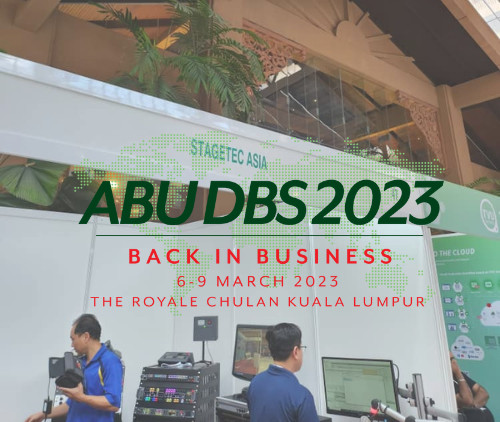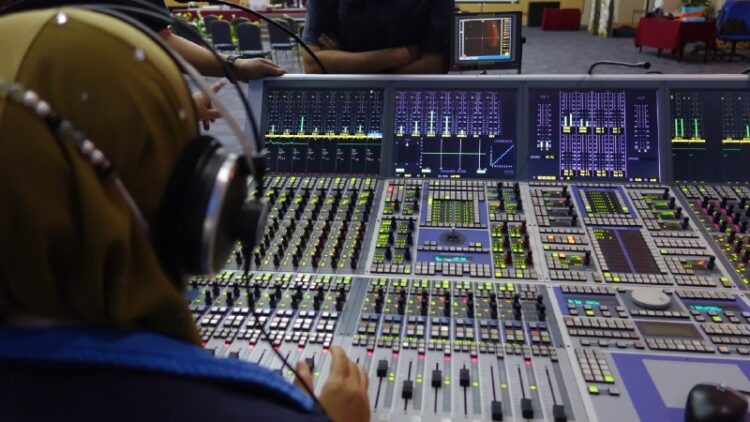
Richard Lawn visits RTM’s impressive new Angkasapuri Kota Media complex, six years in the making and futureproofed for the next generation
MALAYSIA: Laying down the gauntlet to the world’s most prestigious broadcast sites, Malaysia recently removed the wraps from its newly constructed media city complex, Angkasapuri Kota Media. For 75 years, Radio Television of Malaysia (RTM) has transmitted the station’s live shows and musical performances to the nation from its famed Auditorium Perdana in the heart of Kuala Lumpur. Six years in the making at a cost of RM860 million, the AoIP-enabled, futureproofed facility demanded the highest quality technology to impress live audiences, performers and viewers alike.
The redevelopment proposal for Angkasapuri Kota Media involved major renovation and modernisation of its existing radio and television broadcasting facilities and auditorium. GDP Architects was commissioned to create a dynamic mixed-use facility in what was an isolated office location, with reconstruction and reconfiguration of existing spaces commencing in December 2016. Today, the 62,027m2 site boasts 18 floors of office space, the 1,000-capacity Seri Angkasa auditorium, a recording/rehearsal studio, three television studios (M1, M2 and M3), a multi-storey carpark and a plaza.

Working closely with systems integrator VME Broadcast Sdn. Bhd., Stagetec Asia won the tender to deploy a Dante/AES67 protocol audio infrastructure. “Our relationship with RTM dates back to 2005 when we supplied our first Stagetec console to the broadcaster,” explains Stagetec Asia managing director, Advon Tan. “Since then, we’ve not only supplied products and technologies but consultation services, including for the existing Auditorium Perdana. Stagetec’s excellent product reliability and after-sales service enhanced our credibility sufficiently to become involved with this mega broadcast project.”
The main challenge facing Stagetec during the expansion’s design phase was to provide an open-source interface for a plug-and-play ecosystem using external equipment that would shorten installation time. All the audio-related infrastructure, including the intercom and stage monitoring systems are interconnected via Stagetec’s Nexus routers. In addition to the auditorium, which hosts major civic events and plays, Stagetec Asia also successfully bid for the three M studios.
Stagetec Asia managing director Advon Tan
The mixing platform comprises of five interconnected Stagetec Crescendo Platinum consoles. Located in the studio production and OB gallery at the rear of the auditorium, a 48-fader Crescendo Platinum is paired with a Genelec 8330A 5.1 surround sound setup, with 40-fader versions located within the auditorium for front-of-house and monitor duties. For studio recording in the M1, M2 and M3 studios, 32-fader versions are in daily operation. Both the monitor and front of house Crescendo Platinum consoles are connected to the Dante, MADI and Nexus fibre optic signal networks.
Capable of routing 4096 inputs to 4096 outputs, the extensive requirements demanded for RTM Media City’s broadcasting and production facilities is duly delivered by a Nexus Star routing topology. With the insertion of Nexus XDIP interface cards within the I/O boards of the 6-u height Nexus Star, bi-directional, redundant Dante and AES67 networking is created for over 8000 channels.

“We enhanced the Nexus routers throughout the facility by incorporating processing modules,” says Tan. “The XMIC+ microphone input board features eight TrueMatch 32-bit converters with a dynamic range of 158dB, each with a 4-channel active microphone splitter. Each of the channels has separate gain control, adjustable impact sound filters and a phase inverter and provides permanent self-monitoring and self-calibration, allowing for flexible routing and distribution of separate signals across the entire Nexus audio network.”
The Stagetec team with Crescendo Platinum console and Genelec monitors in the auditorium’s broadcast suite
Powered by six Nexo NXAMP4x1 Mk2 amplifiers, 24 Nexo P12 stage monitors within the auditorium are also connected to the Nexus and Dante networks. With the insertion of immersive and virtual splitter mic cards, the Nexus Star topology divides the microphone input signals between the monitor and FOH consoles. “As the auditorium is fully equipped with two loudspeaker systems, we needed to split the microphone inputs to four locations each with individual control of mic preamps, high pass and low pass filters,” explains Tan.

The main L-R loudspeaker arrays each comprise of 12 L-Acoustics KARAi II modules, with a centre array of two A15i cabinets. Low-end reinforcement to 25Hz is provided by six centrally suspended KS28 dual 18-inch subwoofers in cardioid mode, with front fill and side fill provided by two-way passive 5XT and 8XT coaxial enclosures, respectively.
In a control room at stage left, eight LA4X amplified controllers power the KARA II, A15 and XT coaxial models, while two LA12X models supply the six KS28 subwoofers. In addition to four-channel amplification, the racked LA4X and LA12X units incorporate crossover functionality, linearisation, L-Drive transducer protection and an onboard library with standard and cardioid presets and low-pass filters.
Each main speaker array comprises 12 L-Acoustics KARAi II modules
In addition to the L-Acoustics system, Stagetec Asia oversaw the installation of an Astro Spatial Audio (ASA) object-based immersive system in the auditorium. Working closely with systems integrator VME Broadcast, ASA was commissioned to make its adaptive room acoustics technology concept a reality. “The previous Perdana auditorium was equipped with a Vivace electro room acoustic system,” says Tan. “When we were invited to discussions with the client regarding the new acoustic system, we proposed the addition of a 3D immersive audio system. In addition to providing a 3D immersive audio experience that integrates smoothly with the Nexus audio network through MADI and Dante connection, it also boasts a short processing delay.”

A live broadcast show in the new Seri Angkasa auditorium
ASA’s SARA II Premium Rendering Engine provides an intuitive web-based GUI with access for simultaneous control. The 3U SARA II processes and transforms up to 128 MADI or Dante configurable network audio signals into audio objects. Making it desirable for live performances, the setup includes extensive metadata to precisely calculate the objects’ positions within virtual 3D in addition to their acoustic effects on the virtual space around them. Being brand agnostic, SARA II connects all loudspeakers, consoles and third-party brands required by the operator.
Having previously been paired with ASA 3D technology at exhibitions and demonstrations, Martin Audio loudspeakers were trialled for suitability. “In combination with Astro Spatial Audio’s algorithm, the prediction models suggested that fewer Martin Audio’s CDD enclosures would be required for deployment to achieve an absorbing result when compared to other brands,” explains Tan. Powered by 10 LEA Professional 3D four-channel amplifiers, 16 CDD12 and 22 CDD8 speakers have been fixed to the auditorium’s ceiling and walls, respectively.
Martin Audio’s Coaxial Differential Dispersion (CDD) technology employed in both the 8- and 12-inch two-way designs provides consistent audience coverage. The CDD driver achieves point source summation of the LF and HF sections to eliminate off-axis variations in frequency response associated with non-coaxial designs. The coaxial driver features a static waveguide that merges with the unique cone shape to maintain the dispersion pattern out to very high frequencies.

Maintaining optimal radio frequency (RF) performance within the capital city’s congested wireless environment, including TV transmissions and mobile devices, a solution was required that would overcome the unpredictable and highly dynamic conditions. Concept Systems conducted thorough RF analysis at the site, located among commercial premises, the Ministry of Information and RTM’s own infrastructures, and discovered significant frequency, power, and satellite channel interference.
The 32-fader Crescendo Platinum monitor console in the auditorium
Thirty-two channels of Shure Axient and ULX-D Digital wireless systems together with 40 PSM 1000 in ear monitor (IEM) sets have been provided throughout the auditorium. The eight Axient AD4Q four-channel receivers receive their UHF signal from ADX2/KSM8 handheld wireless transmitters via ADX1 and AD1 beltpacks. By combining Shure’s Wireless Workbench 6 software and the Axient AXT600 spectrum manager, wireless frequencies can be coordinated between the Axient, ULX-D and PSM 1000 systems. Control and monitoring capabilities are extended to mobile devices with the ShurePlus Channels iOS app. A UA844+ SWB and UA874SWB antenna distribution and combiner system creates a True Multi-Receiver Diversity Architecture. The antenna inputs actively receive and decode the digital signal, and the digital bitstreams provide redundancy by combining to fill in any gaps.
For Angkasapuri Kota Media’s live broa0 Spectrum Manager for automatic frequency hopping to automatically sync both the Axient AD4Q receivers and ADX1, ADX2, and ADX2FD transmitters.

All Shure’s linked devices have been integrated into the Angkasapuri Kota Media system, ensuring that wireless microphones and personal IEM systems can be controlled remotely while on air. This has resulted in clear, stable frequencies being automatically deployed with the spectrum manager, effectively preventing any interference. Reliable in challenging RF environments is achieved by the PSM 1000’s true diversity bodypack receiver, the P10R+, equipped with advanced DSP technology for enhanced signal reception and extended range. The incorporation of CueMode and MixMode technologies provide monitoring of different stage mixes and simultaneous listening in both ears.
The auditorium lighting inventory includes Robe Tarrantula and BMFL Blade fixtures
Dante and MADI networking interconnect the M1, M2 (virtual reality) and M3 studios, where dedicated inventories of portable RCF ST12-SMA II and ST15-SMA II loudspeakers can be flexibly deployed in the live room connected to the M1 studio. Like the auditorium, the studios are amply equipped with Shure Axient wireless microphones and PSM 1000 IEMs for live and recorded broadcasts. Microphones include TH53B Twinplex headset, TL48 Twinplex lavalier and KSM8 handheld models.
Each of the three M studios is equipped with Grass Valley XCU 4210/10 and LDX 86 WorldCam cameras together with Panasonic PTZ remote control cameras. A Clear-Com Eclipse HX communication infrastructure including beltpacks, Eclipse HX and Encore PS702 base stations, LQ AoIP interfaces and CCI-22 dual partyline ring interface modules enables smooth back of house operations.

The GV cameras in both the studios and the auditorium are fibre-connected over the IQ Modular distribution infrastructure. The GV infrastructure continues to respective control rooms where the SDI signals are routed over 3G fibre to racked Wandcam base stations, enterprise-level Sirius 830 HD-SDI 72×72 routers, MV821 multiviewers and Kahuna 6400 digital production switchers. Designed for scaling multiple HD cameras across the network during live sports programming, a Simply Live ViBox Slomo scalable replay system is connected to the Dante network. In addition to a Stanton Video Jimmy Jib Triangle, live broadcasts in the auditorium are captured on Grass Valley Digi Super 22 HD mobile cameras on stage. Meanwhile, performers are illuminated by an inventory of lighting fixtures including Robe Tarrantula LED beam/wash/effects and BMFL Blade fixtures.
“Cost-effectiveness is one of the promising factors provided by the Dante AoIP solution, especially for such a large-scale venue such as Auditorium Perdana,” Tan asserts. “Being able to leverage on a multi-point audio network at an economical rate allows RTM to manage effectively in the long run, ready for world-class live and musical events in the future.”
The audio infrastructure is interconnected via Stagetec Nexus routers
In many venues, audiences ensconced in such luxury and comfort would possibly find themselves battling sleep at some point during a long production. However, with the sensory overload of immersive 3D audio and dazzling lighting effects provided in the new Auditorium Seri Angkasa, audience members should be kept on the edge of their plush reclining seats.
- www.conceptaudio.com.my
- www.mkn.gov.my/web/ms/2022/10/27/angkasapuri-kota-media
- www.stagetecasia.com




